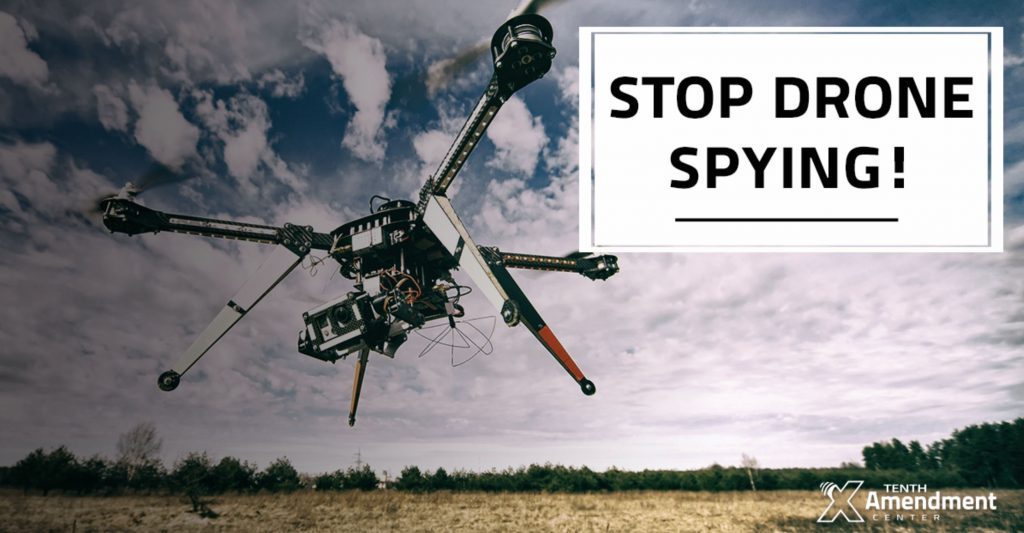Last week, a bill requiring police to get a warrant before engaging in drone surveillance in most situations became law without the governor’s signature. The new law not only establishes important privacy protections at the state level, it will also help thwart the federal surveillance state.
Rep. Diane St. Onge (R-Lakeside Park) and Rep. Reginald Meeks (D-Louisville) introduced House Bill 22 (HB22) on Jan. 2. The new law prohibits the use of a drone for a “search” unless authorized under the Fourth Amendment to the United States Constitution and Section 10 of the Kentucky Constitution. In effect, the officers will now have to get a warrant based on probable cause before gathering information with a drone in any situation that would require officers on the ground to have a warrant. In order for the search to be valid, the warrant must specifically authorize the use of an unmanned aircraft system.
The new law requires police to minimize data collection on non-suspects and prohibits the disclosure of any such data without a court order.
Any information collected in violation of the law is inadmissible as evidence in any civil, criminal, or administrative proceeding in the state.
HB22 also prohibits the operation of any drone equipped with a lethal payload.
On March 6, the Senate passed HB22 by a 38-0 vote.The House previously approved the measure by a 94-0 vote. Gov. Matt Bevin did not sign the bill, but it became law without his signature on March 24.
Impact on the Federal Surveillance State
Although the proposed law would only apply to state and local drone use, it throws a high hurdle in front of some federal programs.
According to a report by the Electronic Frontier Foundation, drones can be equipped with various types of surveillance equipment that can collect high definition video and still images day and night. Drones can be equipped with technology allowing them to intercept cell phone calls, determine GPS locations, and gather license plate information. Drones can be used to determine whether individuals are carrying guns. Synthetic-aperture radar can identify changes in the landscape, such as footprints and tire tracks. Some drones are even equipped with facial recognition.According to research from the Center for the Study of the Drone at Bard College, 347 U.S. police, sheriff, fire, and emergency response units acquired drones between 2009 and early 2017—primarily sheriff’s offices and local police departments.
Much of the funding for drones at the state and local level comes from the federal government, in and of itself a constitutional violation. In return, federal agencies tap into the information gathered by state and local law enforcement through fusion centers and a federal program known as the information sharing environment.
According to its website, the ISE “provides analysts, operators, and investigators with information needed to enhance national security. These analysts, operators, and investigators… have mission needs to collaborate and share information with each other and with private sector partners and our foreign allies.” In other words, ISE serves as a conduit for the sharing of information gathered without a warrant.
The federal government encourages and funds a network of drones at the state and local level across the U.S., thereby gaining access to a massive data pool on Americans without having to expend the resources to collect the information itself. By placing restrictions on drone use, state and local governments limit the data available that the feds can access.
Currently, 18 states—Alaska, Florida, Idaho, Illinois, Indiana, Iowa, Maine, Montana, Nevada, North Carolina, North Dakota, Oregon, Tennessee, Texas, Utah, Vermont, Virginia, and Wisconsin—require law enforcement agencies in certain circumstances to obtain a search warrant to use drones for surveillance or to conduct a search.
In a nutshell, without state and local cooperation, the feds have a much more difficult time gathering information. This represents a major blow to the surveillance state and a win for privacy.
WHAT’S NEXT
HB22 will go into effect 90 days after the end of the 2018 legislative session.


Be the first to comment on "New Kentucky Law Puts Limits on Drone Spying, Will Help Thwart Federal Surveillance Program"